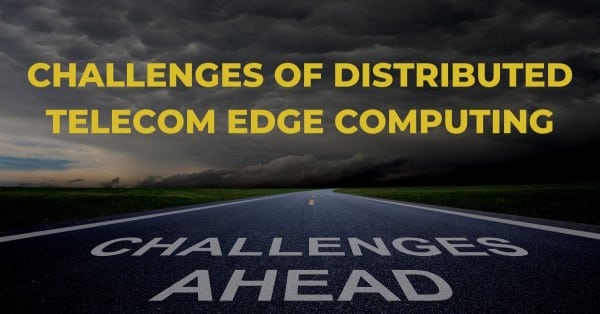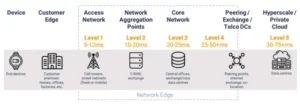- Tech News & Insight
- July 1, 2025
- 5G Americas
Home » 5G Magazine » Challenges of Distributed Telecom Edge Computing
Challenges of Distributed Telecom Edge Computing
Mobile Edge Computing (MEC), is challenging to implement and requires support for network parameters of most of the use cases. Telco Edge nodes are not only contained with network functions but also applications workloads are deployed to deliver services to edge serving devices.
- By Sagar Nangare
- Last Updated: March 16, 2024

Edge computing is all about implementing compute, storage & networking to enable processing closer to data-generating connected devices. There are a few definitions that emerged with the adopters of edge in different architectures. Like edge is different for data center providers, telecom operators, communication service providers, corporate IT departments, manufacturing IoT, retail IoT business, sports, healthcare, and many different software architectures. Implementing edge architecture poses different challenges for different implementations due to the support of varied use cases in different implementations.
For example, ultra-low latency and high reliability are required by autonomous vehicles and remote surgery, higher throughput is required for video-on-demand services, IoT use cases will need a mix of parameters to host and run customized edge applications, intensive computing, and video streaming with high throughput required in cases of AI-based IoT and AR/VR use cases along with storage and power performance support.
Out of the above different edge implementations, the edge for telecom operations, i.e., Mobile Edge Computing (MEC), is challenging to implement and requires support for network parameters of most of the use cases.

Telco Edge nodes are not only contained with network functions but also applications workloads are deployed to deliver services to edge serving devices.
Heterogeneous deployments
Telco edge nodes consist of several infrastructure layers starting from the central cloud, cell towers, C-RANs, and customer edge towards connected devices like sensors, actuators, home appliances, smartphones, and personal computers. A variety of such connected devices use different network access technologies like wi-fi, 2G, 4G, 5G, and in some cases private networks. Also, most of the edge nodes are equipped with multivendor equipment that further creates fragmentation in the virtualization/containerization of workloads, resulting in inconsistent methodologies for hosting network functions along with applications.
Zero-touch network management
Telco edge nodes serve a diverse set of use cases on different types of edge locations. Such edge locations need to configure, deploy, turn up, monitored, and maintained. But this does not bring uniformity in terms of overall management, except for network slicing which enables logical channels for dedicated use cases. Most commonly, use cases require the utilization of edge nodes in different capacities. And in the case of network slicing, configurations for each slice have specific resources to serve the specified use cases.
Due to the complexity of having different implementations in edge zones and multivendor solutions on top of it and the infrastructure involved, each network layer and service become hard to manage. It is not possible to configure each edge node and connected network routers and base stations. Centrally managed automation and AI/ML-based solution is required to control the services and network operations. Further intent-driven network provisioning and management can be also possible. With this, not all of most of the network operations get self-service based with respect to repetitive configurations and processing of requests coming from connected devices.
Edge Services Orchestration
Telco MEC nodes are hundreds and thousands in the number connected to far-edge devices like a server at a gas station, a camera at a retail store, or may a video surveillance unit in a residential society. In the traditional telco model, the focus was on using purpose-built hardware systems or proximity access points like C-RAN or cell towers systems that need to configure manually and the configuration cycle time was on a higher side. In upcoming MEC architecture, this approach cannot be possible when trying to bring all the diverse pieces of network and services edge in a single carrier-grade, cloud-native, and automation mechanism. Telco MECs need to be deployed in close proximity, but it requires to have an easy-to-use, end-to-end solution for edge application management and orchestration. This is especially required as telcos are adopting the multi-cloud strategy and due to this, the edge is becoming complex. To address this, telco MEC requires to have an orchestration solution that will enable faster time to market, agile software development using CI/CD, and high-level automation.
Challenges in terms of MEC Validation
Edge nodes not only host network functions but are deployed with application workloads as well. In a diversified edge environment, network functions come from different network solution vendors, and applications are varied in terms of resource requirements. These two are hosted with VNFs and CNFs orchestrated by Kubernetes or any managed cloud orchestration solutions. Such a complex environment requires
- The assurance of running workloads in different edge locations with different serving capacities
- Validation of platforms hosting the NF and application workloads
- Validation against each of the serving use cases
Lack of common standards for network integration
Implementing MEC is complex due to the amalgamation of multiple solutions and technologies into silo edge nodes. Telcos often source the open software and hardware units from different partners but this results in a complex standardization model including solutions with a variety of standards. This is challenging for a telecom operators to build a single and ready-to-replicate edge model based on multiple vendor solutions.

Sagar Nangare
Sagar Nangare is a technology blogger, who writes on the cloud-native stack, cloud, 5G, edge, multi-cloud, and networking technologies. Currently, he serves as a Manager – Strategic Marketing at ACL Digital.
All Posts
Recent Content
- Tech News & Insight
- June 27, 2025
- Hema Kadia
5G Advanced and AI are reshaping utility private networks into hyper-intelligent, resilient grids. Learn how edge AI, programmable networks, digital twins, and human-in-the-loop automation will enable predictive maintenance, real-time grid optimization, and new energy services.
- Tech News & Insight
- June 27, 2025
- Hema Kadia
Cybersecurity is now a core pillar of utility private networks. Explore how Zero Trust Architecture helps utilities secure SCADA systems, protect distributed energy assets, and comply with NERC CIP standards, keeping critical infrastructure safe in a hybrid IT/OT world.
- Tech News & Insight
- June 27, 2025
- Hema Kadia
Utilities are turning private LTE and 5G networks into revenue engines with monetization and shared use models. Learn how Fixed Wireless Access, neutral host strategies, mobile wholesale partnerships, and edge services help utilities bridge the digital divide, support local economies, and generate ROI from advanced network investments.
- Tech News & Insight
- June 27, 2025
- Hema Kadia
Private LTE and 5G networks enable utilities to achieve sustainability and ESG goals by supporting clean energy, climate resilience, safer field operations, and transparent ESG reporting. Discover how utilities are using private networks to lower emissions, integrate renewables, and protect communities.
- Tech News & Insight
- June 27, 2025
- Hema Kadia
As utilities expand private LTE and 5G networks, strong partner ecosystems and managed services help balance performance, compliance, and cost. Explore how orchestration, governance frameworks, and co-managed models enable utilities to scale smarter and faster.
Whitepaper
Telecom networks are facing unprecedented complexity with 5G, IoT, and cloud services. Traditional service assurance methods are becoming obsolete, making AI-driven, real-time analytics essential for competitive advantage. This independent industry whitepaper explores how DPUs, GPUs, and Generative AI (GenAI) are enabling predictive automation, reducing operational costs, and improving service quality....

Whitepaper
Explore the collaboration between Purdue Research Foundation, Purdue University, Ericsson, and Saab at the Aviation Innovation Hub. Discover how private 5G networks, real-time analytics, and sustainable innovations are shaping the "Airport of the Future" for a smarter, safer, and greener aviation industry....

Article & Insights
This article explores the deployment of 5G NR Transparent Non-Terrestrial Networks (NTNs), detailing the architecture's advantages and challenges. It highlights how this "bent-pipe" NTN approach integrates ground-based gNodeB components with NGSO satellite constellations to expand global connectivity. Key challenges like moving beam management, interference mitigation, and latency are discussed, underscoring...

Download Magazine
With Subscription



















